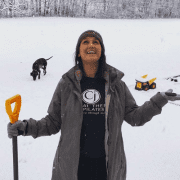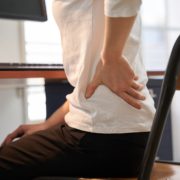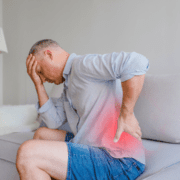A Physical Therapy Expert’s Guide to Enjoying Fall Activities Pain-Free
A Physical Therapy Expert’s Guide to Enjoying Fall Activities Pain-Free
Fall is my favorite season-and I know it is for many of you too. Crisp air, colorful leaves, pumpkin patches, and cozy outdoor gatherings are some things that come to mind. But there’s also raking leaves, picking apples, chopping wood, and moving heavy things like hay bales or pumpkins. Any of these activities can produce unwelcome strain on your body if you’re not careful.
Here’s a guide to enjoying all that fall has to offer-from a back pain and mechanical pain expert-so you can do as much as you want this fall season while keeping your back and joints pain-free.
-
Rake Leaves with Care
Raking is a quintessential fall activity, but it’s also repetitive and strenuous, which can lead to back pain if done improperly. To protect yourself, begin by warming up. Just as athletes warm up before a game, you should warm up before raking. Try a brisk 5-10 minute walk around your yard or neighborhood to get your blood flowing, followed by gentle stretches for your back, shoulders, and legs. A few torso twists and arm circles will help loosen up your muscles and prepare them for the repetitive motions of raking. Next, choose a lightweight rake with a long handle that allows you to stand upright. Avoid bending forward too much, and alternate sides regularly to avoid overusing one side of your body. When bending to gather or bag leaves, squat using your legs and keep your core engaged. Avoid twisting from your waist, as this puts your spine in a vulnerable position. Instead, pivot your entire body to avoid strain. Raking for extended periods can tire out your muscles, making you more susceptible to injury, so set a timer for every 20-30 minutes and take a short break to stretch your back and shoulders.
-
Safely Pick Up and Carry Pumpkins
Pumpkin picking is a fall favorite, but carrying heavy or awkwardly shaped pumpkins can strain your back and shoulders if you’re not careful. Here’s how to keep things safe and pain-free. First, when lifting a pumpkin, bend at your knees and use your leg muscles to power the lift. Keep the pumpkin close to your body and avoid twisting as you lift. If possible, use a cart or wagon to transport heavier pumpkins and prevent carrying strain. Many farms and pumpkin patches provide carts-take advantage of them! If you’re decorating with multiple pumpkins or other fall items, consider limiting the number of trips you make to and from your car or home to avoid repetitive strain. This advice applies to picking up and carrying anything-whether it’s hay bales, fall decorations, or putting away summer furniture.
-
Use Good Posture When Apple and Pumpkin Picking
Apple orchards and pumpkin patches can be so much fun, but both activities involve a lot of bending, reaching, and lifting. Use these tips to protect your body. Instead of overstretching to reach that perfect apple, use a ladder or stool. Overreaching can lead to shoulder and back strains, so play it safe and keep a good base of support as you reach up. When standing or walking for extended periods in the orchard or patch, practice standing tall, with your weight evenly distributed between both feet. This not only helps reduce fatigue but also protects your lower back. Additionally, if you know you’ll be walking and standing for prolonged periods, wear good, supportive shoes. This will go a long way in helping your spine and the rest of your joints absorb the load of your body as well as those pumpkins and apples.
-
Move Often and Stay Hydrated
All-day outdoor fall activities can wear you out, especially if you’re standing, bending, or lifting frequently. Staying mindful of your body can make a big difference. Make a point to take a stretch break every hour or so. Focus on simple movements that lengthen your spine and open up your chest and shoulders, such as reaching your arms overhead and gently twisting your torso side-to-side. Cooler weather can make you feel less thirsty, but it’s still essential to stay hydrated. Dehydration can lead to muscle stiffness, fatigue, and even unwanted spasms and cramps, increasing the risk of strains.
-
Cool Down After Activities
Once you’ve wrapped up your fall fun, give your body a few minutes to cool down and recover properly. A little bit of post-activity care can go a long way in keeping pain at bay. After raking, decorating, or any heavy lifting, spend five minutes stretching your back, legs, and shoulders. Simple stretches like extending your spine backward or pulling your knees to your chest can help relieve tension. After a full day of physical activity, it’s tempting to sink into a couch or recliner, but try to avoid slumping immediately afterward. Instead, sit with a straight back, or go for a light walk. This can help prevent stiffness and reduce the likelihood of soreness.
Enjoy Fall the Pain-Free Way
Fall activities are a great way to enjoy the season and embrace the outdoors, but they don’t have to come with pain and strain. Taking a few preventive measures, such as warming up, being aware of your body, and using proper lifting techniques, can make a significant difference in how you feel afterward. With these tips, you’ll be ready to fully enjoy apple-picking, pumpkin patches, and all the beauty that fall has to offer-with a lot less ache. That being said, if you try every tip I’ve mentioned and don’t notice any difference in how you feel or tolerate these activities, your problem might need expert help. Reach out so we can help you find a mechanical pain expert in your area who can work with you.
Are you local to Portsmouth, NH? If so, consider speaking to one of my specialists in a Free Discovery Session. This 30-min session is a designed to: 1. Make sure we can help you 2. Make sure you’re a good fit for what we do 3. Make sure we’re a good fit for you. Click here to speak with a specialist.
Dr. Carrie Jose, Physical Therapist and Pilates expert, owns CJ Physical Therapy & Pilates in Portsmouth and writes for Seacoast Media Group. To get in touch, call 603-380-7902, or CLICK HERE to get a free guide for preventing back pain.










